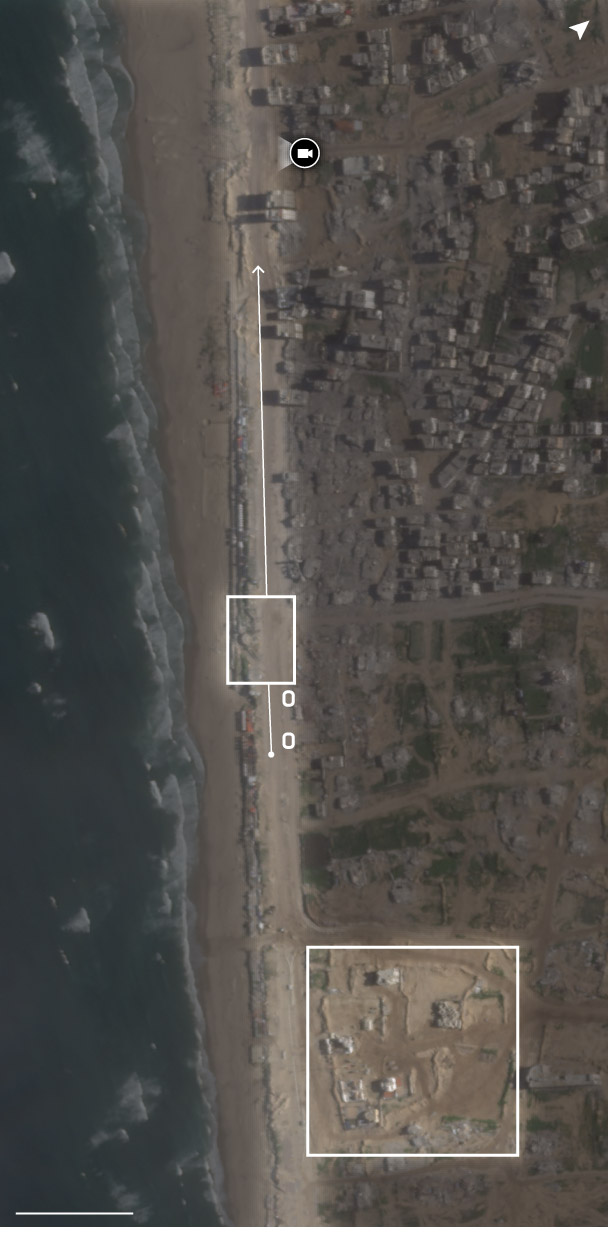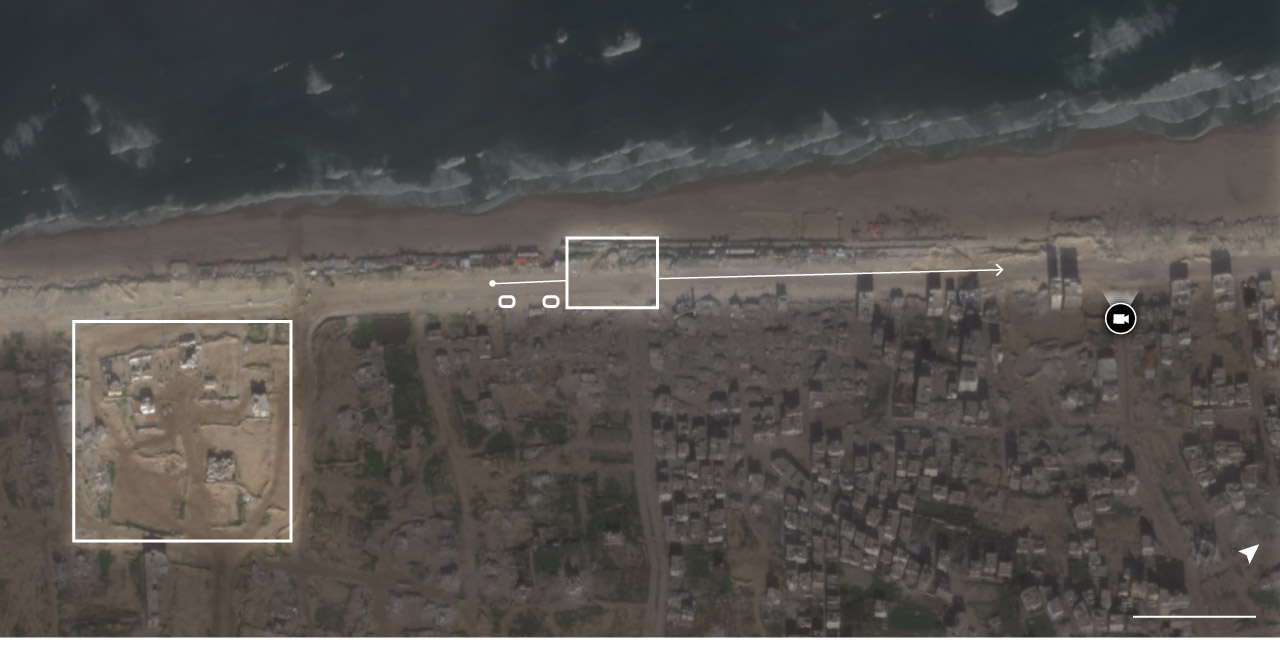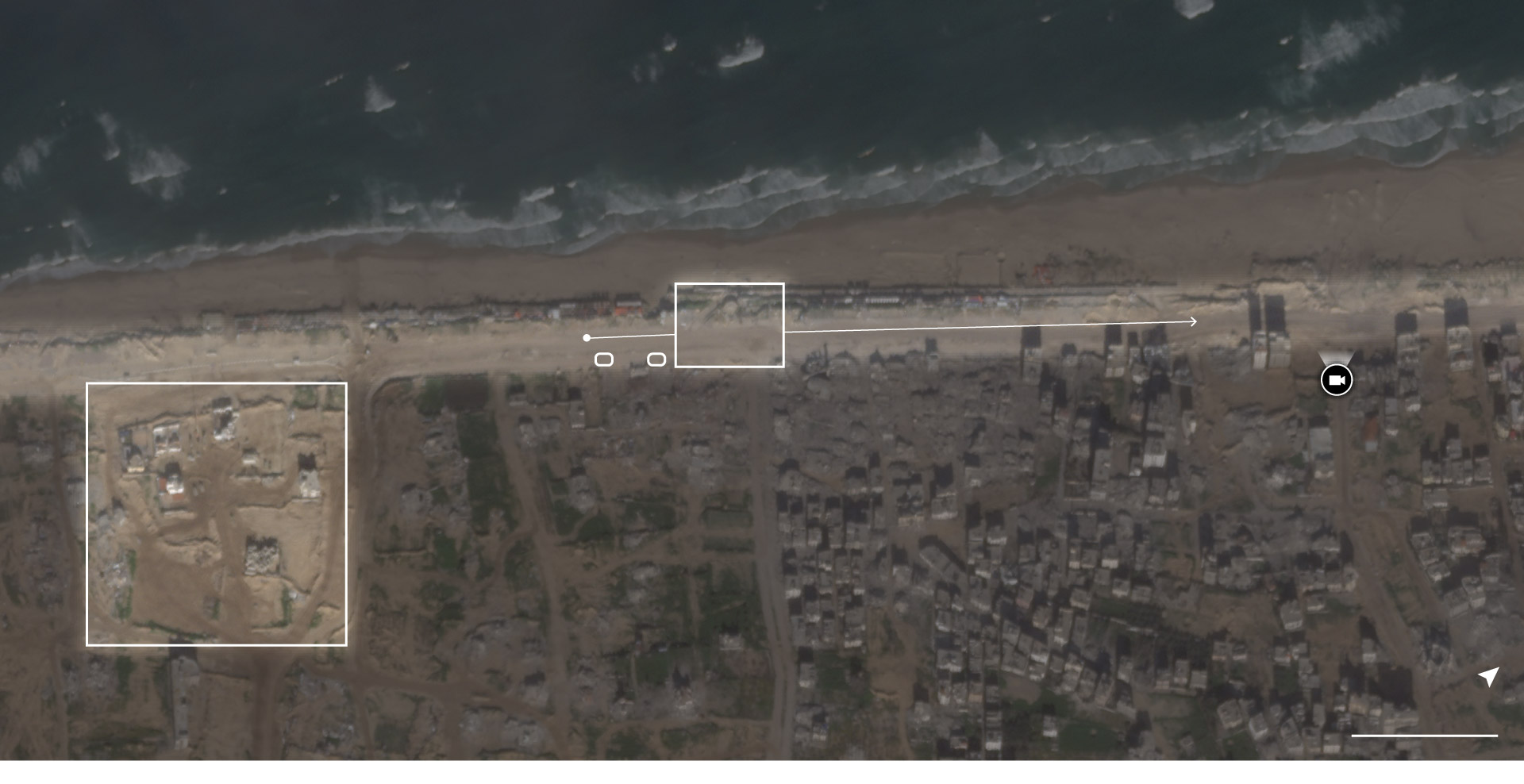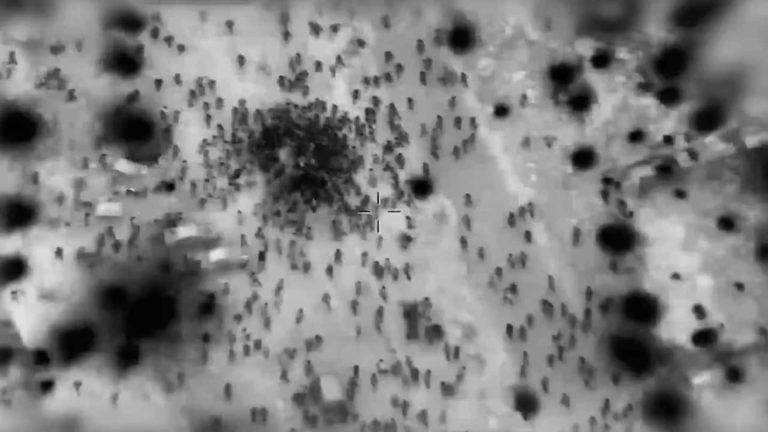Al-Rifi and two of his cousins set out in the dark amid rumors that aid trucks were on the way. Like thousands of others, hunger overcame their fear of the obvious dangers posed by Israeli forces and the desperate Crowds.
Hours later, in the aftermath of one of the most horrific events of the war that produced so much, he returned empty-handed but covered in blood. Both of his cousins were injured and Al-Rifi had to hide among the bodies in a clash that broke out early in the morning when the rare aid convoy crossed an Israeli military checkpoint and entered Gaza City.

The video captures gunshots and tracer fire
People are running and ducking for cover, and lifeless bodies are lying on the road
Satellite © Planet Labs 2024

The video captures gunshots and tracer fire
People are running and ducking for cover, and lifeless bodies are lying on the road
Satellite © Planet Labs 2024

People are running and ducking for cover, and lifeless bodies are lying on the road
The video shows Israeli gunshots and tracer fire
Satellite © Planet Labs 2024

People are running and ducking for cover, and lifeless bodies are lying on the road
The video shows Israeli gunshots and tracer fire
Satellite © Planet Labs 2024
More than 100 people were killed and 700 wounded, according to Palestinian officials, after thousands of civilians crowded onto trucks and Israeli forces opened fire. However, much remains unclear, with contradictory claims from Israelis and Palestinians about what led to the stampede around the trucks, the role of the Israeli shooting, and how many people were shot, as distinct from being injured by the stampede.
On Friday, France, Italy and Germany called for an independent investigation into what happened, after previous criticism by French President Emmanuel Macron of the actions of Israeli soldiers. President Biden said on Friday that the United States will launch an airdrop campaign to deliver aid to Gaza.
Thursday morning's deadly event — which occurred as the Strip crossed the mark of 30,000 dead in the war so far — appeared to fulfill growing warnings that ongoing fighting and mounting deprivation are pushing Gaza's population into a state of lawless chaos.
Al-Rifi said: “I went to bring them food and came back carrying death and blood.”
This account of the tragedy is based on 12 interviews with eyewitnesses, doctors, aid workers, and Israeli and United Nations military officials. Additionally, analysis of dozens of videos, including an edited video released by the IDF, reveals that crowds ran and ducked as bodies lay on the road near two Israeli armored vehicles.
A UN team carrying medicines, vaccines and fuel was able to reach Shifa Hospital in Gaza City on Friday, where it saw “a large number of gunshot wounds” among about 200 patients injured during the humanitarian convoy’s arrival in Gaza. Stephane Dujarric, spokesman for United Nations Secretary-General Antonio Guterres, said in Gaza on Thursday.
Dujarric said hospital workers told the UN team that they initially received more than 700 wounded in Thursday's incident, and all but 200 were released, receiving “the bodies of more than 70 dead.” “I am not aware that our team examined the bodies of the dead. I understand from what [U.N. staff] He added that he “saw” among those “receiving treatment that there were a large number of gunshot wounds.”
The Associated Press reported that the head of Al Awda Hospital in Gaza City said that 176 wounded people were transferred there, 142 of whom were injured by gunshot wounds.
Chaotic and dangerous flyers
Sometime early On Thursday morning, Israeli officials said a convoy of 38 flatbed trucks crossed Wadi Gaza, the creek bed that marks the unofficial dividing line between northern and southern Gaza.
In the south, where more than a million refugees are crowded into makeshift camps, at least some food trucks cross almost daily from Egypt and southern Israel. Very few people have been allowed to travel north, where an estimated 300,000 Gazans are living amid falling concrete and bent rebar of destroyed buildings.
Israel strictly controls access to the north, and has so far refused to open more access points to the area on a regular basis. The United Nations said the last aid delivery to the north was on January 23. A convoy attempting to do so on February 5 came under fire despite coordination with the Israeli army, said Philippe Lazzarini, head of the United Nations Relief and Works Agency for Refugees, UNRWA. He told reporters Thursday.
“When you do a collision avoidance, and even though you dodge the collision, you still get shot at, you think twice about going the next time,” Lazzarini said.
Aid shortages are creating famine conditions in the north, according to small UN exploration teams that have been able to enter the area in recent weeks. Residents living among the ruins say they have searched every inch of the area in search of food.
“Without mercy, we began to feed on the grass of the land,” Yousry Al-Ghoul, 43, told The Washington Post in a phone interview Thursday.
He was among a large crowd of Gazans who began gathering late Wednesday on Al-Rashid Street in Gaza City. They read reports on Telegram or heard orally that a convoy was heading to the Nabulsi roundabout on the street. But no one knew exactly when he was scheduled to arrive Or he seemed able to determine who was sending aid.
The United Nations said the trucks did not belong to it. The Israeli military coordinates the movement of humanitarian and commercial goods throughout Gaza, but has refused to reveal who paid for the convoy, what goods it was carrying, or who contracted with the truck drivers. It is still unclear who the security men were accompanying the convoy.
The army said Thursday's convoy was the fourth convoy heading north in recent days. The pre-dawn timing was intended to avoid attracting dangerous crowds, according to a person familiar with the deliveries who spoke on the condition of anonymity to discuss a sensitive matter.
As news spread of the arrival of another convoy, more and more Gazans emerged from where they had been sheltering.
Aid groups have warned that aid is becoming more chaotic and dangerous across the Strip. An off-target airdrop of food parcels by the Jordanian Air Force last week caused dozens of civilians to fall into the sea while being pursued. Many caravans were plundered. With the collapse of the regime, American officials warned Israel that Gaza would become “Mogadishu.”
At least two Israeli armored vehicles were present on Al-Rashid Street as the aid trucks passed, according to a Washington Post analysis of the visuals and several witness accounts. More Israeli forces were stationed at a military site 400 yards to the south.
Al-Rifi said that the weather was cold and still dark an hour and a half before sunrise as the trucks approached.
Israeli army spokesman Daniel Hagari said late Thursday that the head of the convoy crossed the checkpoint at around 4:40 a.m. He added that the army was deployed to keep Al-Rashid Street, a coastal road linking the north and the south, open as a humanitarian corridor.
As the trucks arrived, still under the cover of darkness, an Israeli drone filmed the scene from above using a thermal camera. The video, released by the Israeli army, shows hundreds of people streaming towards the trucks as they slowly move north along Al-Rashid Street.
The Israelis described the scene as an attack on the trucks, which began around 4:45, eventually leading to what officials described as limited Israeli fire. And civilians being crushed by vehicles and each other.
“A mob ambushed the aid trucks, causing the convoy to stop,” Hajjari said. But several witnesses said the real panic only began when Israeli soldiers and tanks began firing, wounding civilians and sparking a stampede. Contrary to Israeli claims, the Palestinians say that the bulk of the deaths and injuries were caused by Israeli fire, not the stampede.
“A mob ambushed the aid trucks, causing the convoy to stop,” Hajjari said.
“There were tens of thousands of people scrambling to get food, and suddenly, without any warning, Israeli tanks started shooting,” said Al-Rifi, who was trying to reach the parcels with his cousins.
He said they ran while people fell nearby. Al-Rifi added that at some point he hid among the bodies, before taking refuge in an abandoned house. He added that the shooting continued for about 30 minutes. He saw one of his cousins crawling to safety, his leg covered in blood. He will learn that both of his cousins have been infected.
He added: “They opened fire on us randomly.” “This coincided with the firing of a large number of artillery shells, and shrapnel flew everywhere.”
The footage shared by the Israeli military has been edited, making it difficult to determine the sequence of events. But at some point, several bodies can be seen lying on Al-Rashid Street alongside two Israeli military vehicles, as trucks slowly advance north.
In the same location, while bodies are still visible on the road, the drone's camera suddenly pans and zooms in to show people running away, some hiding and hiding behind walls.
The video filmed by Al Jazeera, At an unknown time, people are shown scrambling over the berm to get away from gunfire as red tracer rounds light up the night sky. The Post geolocated the video at the intersection of Al-Rashid and Aoun Al-Shawa Streets, about 700 yards from where drone footage showed lifeless bodies on the road.
The first tracer shots were aimed at or near ground level, based on their trajectory shown at the beginning of the video. Subsequent rounds appear to have been shot higher. The newspaper was unable to verify whether anyone was injured or harmed by these shots. When tracer ammunition is used, the base of the fired projectile ignites, leaving a dense, bright trail of light along the flight path. Ammunition is typically used to illuminate the firing path to improve targeting accuracy.
Al-Ghoul said that he hid at the first sound of gunfire. He was still hearing gunshots two hours later when he was on his way towards the Al-Shati refugee camp west of the city, where his family was staying. He returned home with little to show for his horrific night.
He said: “What arrived were some canned goods that people today paid for in blood.”
Israeli officials disputed accounts of heavy Israeli gunfire and denied firing any tank shells. Hagari described only “a few warning shots in the air” aimed at crowd control.
Officials admitted that a second, bloodier confrontation occurred after the last convoy truck passed and some civilians headed toward a tank and soldiers at the checkpoint.
A military official said: “The soldiers fired warning shots in the air and then opened fire on those who posed a threat and did not move away.” They refused to estimate the number of infected people.
By 6:30 a.m., journalists in the area were publishing photos of bodies, wounded and blood-stained aid packages. The survivors were helping to extract the wounded in any way they could. Al-Khatib rode a donkey cart to Al-Shifa Hospital, but was told they could not handle any more casualties.
A video posted by Shehab News Agency on Telegram and verified by The Post from Kamal Odwan Hospital showed the hospital and other facilities crowded. Hossam Abu Safia, director of the hospital, told the newspaper that 12 bodies and 175 wounded had arrived, many of them victims of multiple gunshot wounds.
Muhammad Salha, a doctor at Al Awda Hospital, said that surgeons performed three operations, including amputations, under battery-powered lights, and they had at least 12 operations ahead of them.
“By the end of this day, the operating room will no longer be able to function,” he told The Post on Thursday.
Al-Rifi loaded his cousins onto his tuk-tuk, making two trips to four hospitals before finding help at Al Awda Hospital. He added that they have been examined, but are still waiting for treatment.
Al-Rifi said that he would not return to drop more aid.
“I would rather die of hunger than be shot.”
Harb and Pepper reported from London and Baran from San Francisco. Hazem Balousha in Amman, Evan Hill in New York, Claire Parker in Cairo, Louisa Lovelock in London, Karen de Jong and Kate Brown in Washington, and Loveday Morris in Berlin contributed to this report.

